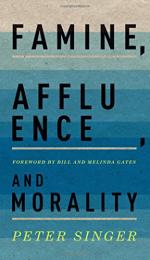|
This section contains 1,487 words (approx. 4 pages at 400 words per page) |

|
Summary
Singer opens his essay with the following words: “As I write this, in November 1971, people are dying in East Bengal from lack of food, shelter, and medical care” (239). These words signal his intention to hedge his philosophical argument within a real-world example, specifically, the Indian famine that happened in the early 1970s. In this first section of the essay, Singer makes it clear that his aim is to examine the moral repercussions of the human response to the situation in East Bengal and others like it around the world.
Singer claims that there are many reasons for the development of famine in East Bengal, citing “constant poverty, a cyclone, and a civil war,” which has led to nine million people becoming “destitute refugees” (229). He contends, however, that their situation is preventable through human actions, but economically developed nations have not done enough to help...
(read more from the Section 1 Summary)
|
This section contains 1,487 words (approx. 4 pages at 400 words per page) |

|




